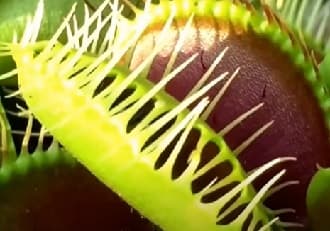As an Amazon Associate, this site earns commissions from qualifying purchases. For more details, click here.
We know how Venus flytraps shut their traps when a prey gets caught. But how does the plant tell the difference between a bug and debris? I’ve wondered about that too and so have scientists. Now we know how.
Venus flytraps do not have brains, but they are able to count and store short term memory in cellular calcium blocks. Based on current research, Venus flytraps can count up to five.
In the rest of this article I will explain how counting helps Venus flytraps distinguish between insects and inanimate objects, and how and why they can do this.
How Do Venus Flytraps Count?
Each trap on a Venus flytrap has sensory hairs. If something falls into the trap, it triggers electrical information.
This electrical data is turned into a calcium wave but the trap doesn’t close just yet. This is where the plant’s counting ability comes into play.
If a fly drops onto the trap, it will stimulate the sensory hair and produce an electrical signal. This signal goes all over the trap but it will do nothing for now.
The trap waits for another action potential to occur within 30 seconds. If an action potential does take place, the trap will shut.
But if the action potential occurs after 30 seconds, the first stimulus will be ignored and the trap remains open.
This proves two things: one, Venus flytraps can count, and two, these plants have memories. The research team led by biophysicist Rainer Hedrich and biologist Mitsuyasu Hasebe confirmed this.
But how can Venus flytraps count and retain memory if there is no brain? There is no question the plant can count, and the process shows it can forget and recall events. But how?
Venus Flytrap Count and Memory Mechanism
Venus flytraps can count and memorize by using a cellular calcium clock. For a long time scientists knew that calcium was involved, but it was only proven through genetic engineering.
To recap, the theory was that electric signals and calcium are responsible for the Venus flytrap’s memories.
To prove this, scientists genetically modified a Venus flytrap and added a calcium sensor to it. The sensor gets lit when the calcium level reaches a certain stage.
By implanting this protein in the Venus flytrap, the researchers were able to detect any increases in calcium when any of the traps get triggered.
What Happens When Venus Flytraps are Triggered?
When its sensory hair is triggered, the calcium level in the trap increases rapidly. The calcium goes all over the trap like a wave, hence the name.
This only lasts for a few seconds however. If there is no additional stimulus, the calcium wave dissipates and the trap does not move.
But if another stimulus or action potential follows within 30 seconds, it’s a different matter.
The first stimulus boosts calcium level, and if the second occurs within the 30 second time frame, the two overlap and the trap shuts.
In simple terms, Venus flytraps add the calcium value of the two action potentials. If the second stimulus occurs inside half a minute of the first, the trap shuts. Otherwise it remains open.
When the trap closes, the Venus flytrap waits for three more stimuli or action potential before releasing its digestive enzymes and eating the prey.
If the count does not reach five action potentials, the trap will open after 12 hours. This is how biologists learned Venus flytraps can count up to five.
Why Do Venus Flytraps Count at All?
Because Venus flytraps need to eat insects this ability is essential. Without the capability to count and have short term memory, the plant will not survive for long.
A trap can close for a limited number of times only before it falls off and dies. If your Venus flytrap is healthy the fallen trap will be replaced by a new one.
Since each trap has a limited lifespan, it developed a mechanism to count the electrical impulses generated by its traps. If it didn’t, it would waste energy trapping debris and dirt.
There are still a lot of questions that need to be answered. Researchers do not yet know how Venus flytraps developed this ability and why it involves calcium. But studies are now underway.

Does Counting Prove Venus Flytraps Think?
Venus flytraps sometimes seem more like an animal than a plant due to the way it traps and eats prey.
Now that biologists have shown that Venus flytraps can count, this makes the plant even more animal-like. But does this prove Venus flytraps can think?
No it does not. Venus flytraps cannot think. This is impossible because they do not have a brain or even a nervous system.
While there are a lot of questions as to how Venus flytraps developed the ability to count, we know it is connected to calcium waves.
Being able to count is essential for Venus flytraps to survive. It is most likely an evolutionary trait the plant developed to thrive. Because without it, the plant won’t be able to tell the difference between an insect and a rock.
This is why when you feed Venus flytraps Orchid Gene or other inanimate food, you have to stimulate its sensors first.
How Far Can Venus Flytraps Count and Remember?
Venus flytraps are known to count to five, but can it go further? It seems like Venus flytraps can only count up to five. Future research might prove this wrong but it seems unlikely.
The reason I say that is because the five count serves its purpose. There is no reason for Venus flytraps to count any higher.
To go over the count again:
A object falls into the trap, triggering an action potential. The Venus flytrap waits for another action potential to occur inside 30 seconds.
If nothing happens, the first action potential is ignored. If another follows, the trap closes. Then it waits for three more action potentials before releasing digestive enzymes.
All it takes is five counts for a Venus flytrap to distinguish between a possible prey and an inanimate object. There is no need for it to count beyond that.
As for its memory, Venus flytraps can remember the previous 30 to 60 seconds. Scientists proved this when the plant ignored action potentials that occur after 30 seconds. After a minute, the initial calcium wave also disappeared.
We don’t know yet if a Venus flytrap’s memory goes back further. But there doesn’t seem to be a need for that.
Venus flytraps only have to recall the last 30 seconds to know if there had been a stimulus. If there was and another event occurs, it will proceed to trap. If not, the actional is ignored.
There is no need for the plant to remember anymore. At least that is what we know so far. The truth is there are still a lot that we do not understand about this carnivorous plant.
Frequently Asked Questions
How can Venus flytraps remember when they don’t have a brain?
It likely has something to do with the calcium wave the plant generates when its sensory hairs are triggered. It could also be related to the way the Venus flytrap counts.
Can a Venus flytrap remember what type of prey it eats?
No. Venus flytraps only recall the action potentials and the interval between each one. That is the only way it can tell a bug from a rock.
Do all Venus flytraps count and have memories?
Yes, but there are mutations that can cause a Venus flytrap to forget how to count. LNK The reasons why this happens is unclear. but it might have something to do with the plant’s genetics or environment.
Does age affect a Venus flytrap’s ability to count or remember?
It doesn’t seem to be the case. The cases where a Venus flytrap “forgets” how to count is due to a mutation rather than age.

My fascination with carnivorous plants began many, many years ago with Venus Fly Traps. Now I am more than happy to impart what I know with other enthusiasts and those who are curious about meat eating plants.


